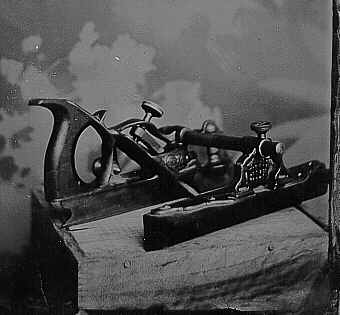

The end of The Civil War saw a tidal wave of new gizmos from the companies that formerly manufactured the wartime products; these companies were forced to sink or swim by quickly changing their product lines and targeting them for general consumption. For example, The Providence Tool Company, of Providence, Rhode Island, started their business making hardware and edge tools, quickly re-tooled to become an Armory, and then went back to hardware manufacture.
It was after the War's cease fire that the explosion of plane development and patents occured. The technology that was used to make the tools of war and death were now used to make the tools of the trades and of life (can't forget coffins, so can't entirely escape the death thingie). The great revolution in the machinist trade now allowed tools that were once thought impossible and unimaginable to become reality. The technological quantum leap that would make the wooden planes, in use for centuries prior, obsolete would eventually make the new tools themselves obsolete in short order.
Great lengths were made to take whatever function was capable in a wooden plane and transfer that same function to a metallic plane. Of all the metallic planes, the wooden plough plane, which was the focal point of the cabinetmaker's chest and capability, received the most elaborate and decorative attention during this revolution in plane design. No respectable cabinetmaker would dare trade in his exotic wood plough, possibly trimmed in ivory, for some ugly cast chunk of metal. No, the metal had to have form, function, and glitz for that transition to happen.
Fast forward to ca. 1875, and we have the debut of the Mayo's Patent Plough Plane, hatched partially in the mind of Matthias Mayo after he made some subtle design changes to the earlier Phillip's Patent Plough Plane. It's fairly obvious that this plane isn't your garden variety chunk of metal. It's curves a-go-go, gold paint, and Brazilian rosewood on this one. And, if that weren't enough, Mayo drove the superiority of the plane home by having the plane cast with "'The Boss' Plane" on its right side. Like, that's boss, man, you know?! Not content with that alone as an identifying feature, Mayo decided to have his name forever glorified in tooldom by casting "M", "A", "Y", and "O" in the four large thumb screws (each thumb screw has just one letter); Mayo certainly wasn't going to let us forget that it was his tool we were using.

Now, what of this black and white image we see here? Yes, it's a Mayo's Patent, and yes, it's an old tintype photograph taken at the same time the plane was new. What ever posessed someone to spend some real money to have his plane photographed? Did he love the plane so much that he had to have it in his wallet with him wherever he went? Did he whip it out proudly to show his drinking buddies in the local saloon? Did he fancy still lifes and failing to find a cornucopia of fruit he grabbed whatever was handy to photograph? All these possibilities seem remote.
What does seem plausible is that this image is a salesman's aide. Instead of lugging around a large plane, risking losing it or damaging it, the salesman could virtually place the plane into the hands of prospective clients, both hardware merchants and tradesman. This idea makes sense when one considers that the photographic procedures were still undergoing rapid development and that they were relatively expensive; whatever spare money could be found in the coffee can would sooner be spent on an image of a person than it would an inanimate object.
It's interesting to note that the plane appears to have been photographed with its fence on the wrong side. However, the plane is set up correctly, with the fence on its left side. It's the photograph that's deceiving as it's the mirror image of the plane. Trick photography existed back then, even if trickery wasn't the photographer's intent.
pal, February 21, 1998